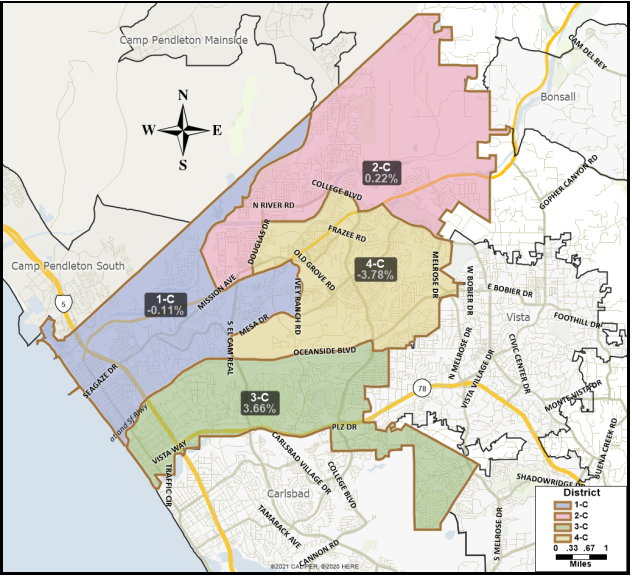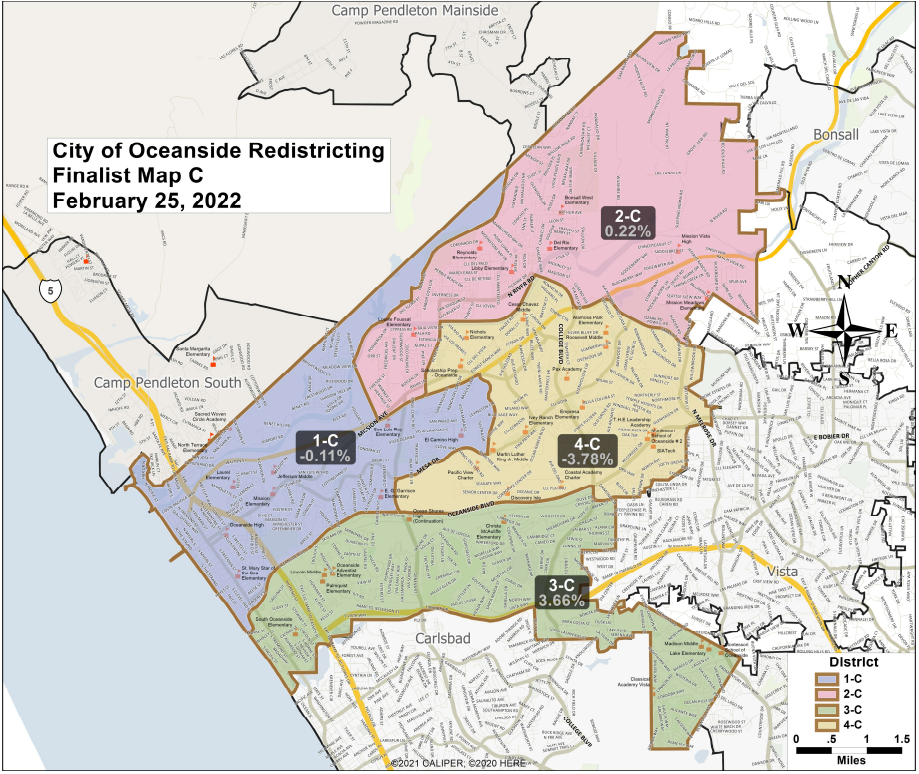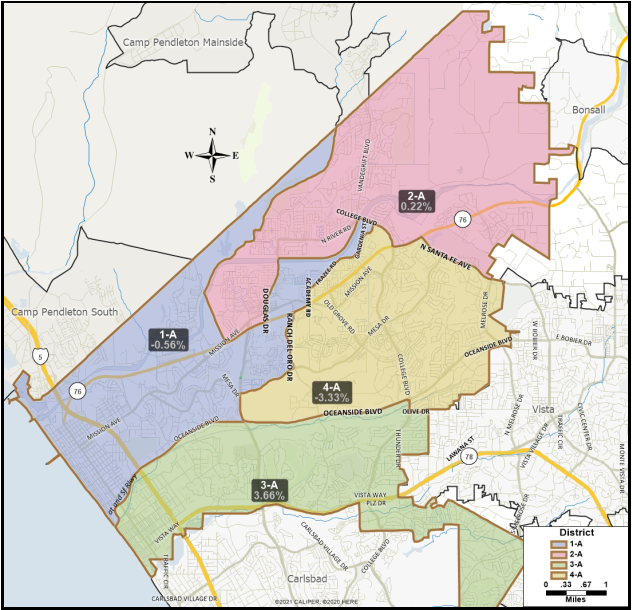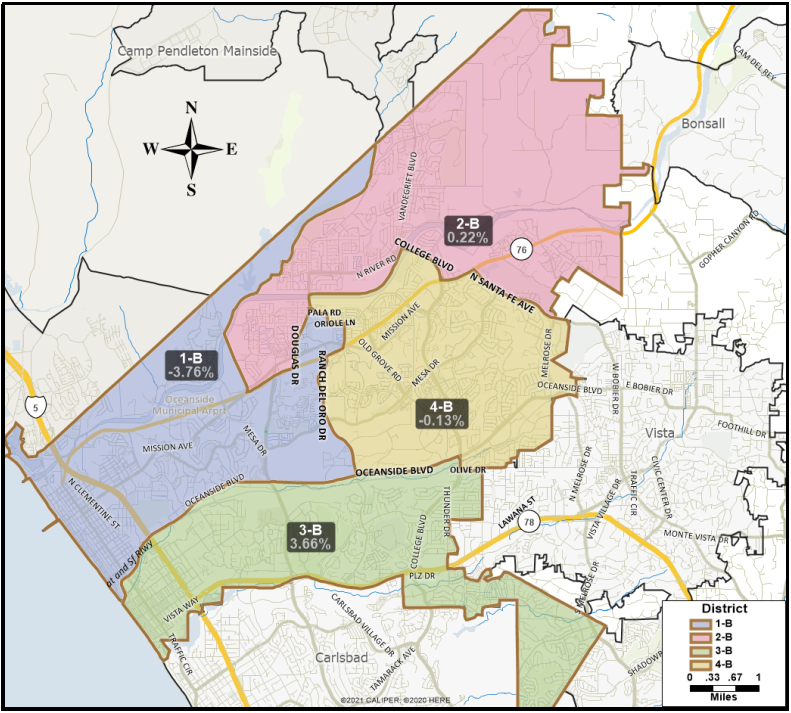
- Home
- »
- ...
- »
- City Clerk
- »
- Elections / Fair Political Practices Commission Reporting Program
- »
- District Elections
Redistricting 2022
The following information can be translated by clicking "Select Language" at the very top of this page and choosing from the drop-down menu. Please note that this feature is not available on Internet Explorer. (La siguiente información se puede traducir haciendo clic en "Select Language" en la parte superior de esta página y eligiendo de la lista. Por favor tenga en cuenta que esta función no está disponible en Internet Explorer.)
Overview
Redistricting is the process of adjusting district lines to reflect local populations changes, so that each district continues to contain nearly the same number of people as the other districts. It is required to occur when census data is released every 10 years. Throughout this process, we are seeking public input on where district lines should be drawn and what communities or groups are important to keep together.
Find Your City Council District
Search for your District by address (click this link or the map below)
Final Redistricted Map
Click the map below to enlarge
Please submit your COI testimony before February 10, 2022 for it to be considered in the draft map.
|
Provide input on your Community of Interest |
Finalist Draft Map
Click the map below to enlarge
Draft Redistricted Maps
Below are the 3 draft maps currently being considered by the City Council (click on map to enlarge)
Click here to view demographic data for each draft map
Previous Deviations by Council District

|
District |
Population |
% Deviation |
| 1 |
39,797 |
-8.82% |
| 2 |
43,816 |
+0.39% |
| 3 |
45,613 |
+4.51% |
| 4 | 45,352 |
+3.91% |
Frequently Asked Questions
Why is the City of Oceanside enacting the redistricting process now?
All cities with city council districts must engage in “redistricting” every 10 years following the decennial federal census in order to ensure that all districts continue to have equal populations and follow all state and federal laws. In 2018, the Oceanside City Council transitioned to a district-based voting system to elect its City Council members, replacing its at-large election system. The City of Oceanside must now ensure that no changes are needed in light of the new 2020 federal census data and must go through the regular decennial redistricting process.
How can I get involved in the redistricting process?
The redistricting process is designed to be as transparent and accessible as possible. You are invited to attend one or more of the City Council hearings and workshops to provide input in person. Please see below for the schedule. You can also provide input by mail or email or by dropping off materials to the City Clerk. Please see below for the contact information. You can also submit input online via the Oceanside Online Redistricting Tool where you can draw districts and/or full redistricting plans. Additionally, you can provide Community of Interest testimony online. Please see the instructions “How to Submit Your Oceanside COI Online.”
When and where are the meetings?
The redistricting process timeline is prescribed by the California Election Code. Section 21627.1. This requires that Oceanside hold at least one public hearing before the Council draws a draft map or maps of the proposed council boundaries and at least two public hearings after the Council has drawn a draft map or maps of the proposed council boundaries. All public hearing buildings shall be accessible to persons with disabilities, and translation services shall be available upon request (at least 72 hours before the meeting).
|
Date /Time |
Meeting |
Location |
|
Wednesday, January 12, 2022 at 6pm |
Public Hearing 1: Overview and training on the process and criteria |
City Council Chambers |
|
Wednesday, January 19, 2022 at 6pm |
Community Outreach Meeting 1: Receive public Community of Interest testimony in workshop-style, non-council meeting |
Civic Center Library Community Rooms (District 1) 330 N. Coast Highway, Oceanside, CA 92054 |
|
Saturday, January 22, 2022 at 11am |
Community Outreach Meeting 2: Receive public Community of Interest testimony in workshop-style, non-council meeting |
El Corazon Senior Center (District 4) 3302 Senior Center Drive, Oceanside, CA 92056 |
|
Wednesday, January 26, 2022 at 6pm |
Public Hearing 2: Receive Community of Interest testimony, then get directions for visualizations, present an “over/under” map |
City Council Chambers |
|
Wednesday, February 2, 2022 at 6pm |
Community Outreach Meeting 3: Receive public Community of Interest testimony in workshop-style, non-council meeting |
Lincoln Middle School Multi-Purpose Room (District 3) 2000 California Street, Oceanside, CA 92054 |
|
Saturday, February 5, 2022 at 11am |
Community Outreach Meeting 4: Receive public Community of Interest testimony in workshop-style, non-council meeting |
Melba Bishop Recreation Center (District 2) 5306 N. River Road, Oceanside, CA 92057 |
|
Wednesday, February 9, 2022 at 6pm |
Public Hearing 3: Show visualizations, begin drawing draft map live based on public input and Council direction |
City Council Chambers |
|
Wednesday, February 23, 2022 at 6pm |
Public Hearing 4: Receive feedback on the draft map(s), make changes live and in-person, finalize map |
City Council Chambers |
|
Wednesday, March 9, 2022 at 6pm |
Public Hearing 5: Receive any additional feedback, vote on Final Map |
City Council Chambers |
|
Our demographer will also be hosting office hours. Join one of the below meetings to ask any questions about the mapping tool https://us02web.zoom.us/j/88610977185?pwd=L2dMVFE3TEt0VThkLzVOZzZOdllXQT09 Friday, January 28, 2022 3:00-5:00 p.m. https://us02web.zoom.us/j/89606145915?pwd=QzNPR3JDRTNteDlYQzA1dGdWZWRBUT09 Saturday, January 29, 2022 12:00 - 1:00 p.m. https://us02web.zoom.us/j/81790634353?pwd=ZUg3RHlXVkt5YjQrbDJWK0JFcGRGQT09 Monday, February 7, 2022 12:00 - 1:00 p.m. https://us02web.zoom.us/j/81021574243?pwd=M3RVYUdaV1NrNGpZdEdXOExnTVFSUT09 |
How are the districts drawn?
Generally, the following criteria are used to redraw the council districts (California Elections Code. Section 21601):
● Each district should contain nearly the same number of people;
● Boundaries shall be drawn in a manner that complies with the United States Constitution and the Federal Voting Rights Act;
● Council districts shall consist of contiguous territory in as compact form as practicable;
● Districts shall follow visible features and boundaries when possible;
● Council districts shall respect Communities of Interest as much as practicable. Communities of Interest generally refers to a contiguous population that shares common social and economic interests that should be included within a single district for purposes of fair and effective representation;
● The demographer will disregard the location of incumbents and candidates, as well as the interests of political parties.
In summary, this means the following:
● We will use a mapping program to construct districts after public input has been received.
● Census data will be used to find out how many people live in each part of the city and ensure that each district contains roughly the same number of people.
● Census geography will be used to ensure that the districts are compact and contiguous
● We will collect and utilize Community of Interest data from the residents of Oceanside to use in the building of districts.
● We will not use any address information for current council members or potential candidates or use political party affiliation or information in the drawing of districts.
How many people should be in each district?
As counted by the 2020 Census, the City of Oceanside had a total population of 174,578. The decennial census is the only survey that counts everyone, so we have to use that data to draw districts. There will be 4 council districts. To figure out the ‘ideal population’ for each council district, take the total population (174,578) and divide it by the number of districts (4) which equals approximately 43,645 persons.
Do we use the number of voters to draw districts?
Districts are drawn using the total population as counted by the last census. Everyone who was counted, irrespective of age, residency status or other demographics has to be assigned to a district. Districts are not equalized using voters, registered voters or citizens.
Why should I get involved in the redistricting process?
We would like to hear from you so we can make informed decisions about where to draw district lines. Specifically, we need information from you about your neighborhoods and communities of interest. You are the expert who knows your community and neighborhood! If we know the geographic locations of the Communities of Interest (COI) in Oceanside, we can consider them when drawing lines and we won’t inadvertently split them! Keeping communities together in the same district can help to get more responsive representation. Please submit COIs by February 10 to be considered in the first draft map(s).
What information do you need from me?
One of the criteria to draw maps is called “Communities of Interest” or COI. Because there are no datasets available for Communities of Interest, we appreciate your help to define them for the City of Oceanside. A COI is a group of people in a defined geographic location that share a common bond or interest. A Community of Interest is defined as “a contiguous population which shares common social and economic interests that should be included within a single district for purposes of fair and effective representation.” Please tell us what defines your Community of Interest, where it is located, and why it should stay together.
Communities of Interest
A COI is a group of people in a defined geographic location that share a common bond or interest. The definition is broad, leaving communities a lot of discretion in determining which issues are important to them. Communities of Interest are often defined as “a contiguous population which shares common social and economic interests that should be included within a single district for purposes of fair and effective representation.”
Communities of Interest are best documented through oral, written, or digital input from individuals or groups with first-hand knowledge of them. Census and other outside data can lend support, but cannot replace personal knowledge of the community. That’s why we want to hear your feedback on your community; you know it best!
How to create your Oceanside Community of Interest Online
Community of Interest Written Description Form
The 3 Steps to document your Community of Interest:
1. What is the nature of the bond or common interest of your community?
Please describe what the common interests of your community are, and why or how they are important. For example:
● If your Community of Interest is built around a school then your testimony should include the name and location of the school and describe the community’s involvement in it or why it is important. You might say that the surrounding community is involved with the school in various ways and perhaps accesses a variety of educational and recreational opportunities there.
● You may also identify a Community of Interest based on a shared culture or heritage of residents in a specific area. Please indicate why it is a common bond, e.g. “because of our shared history and language, we work together on cultural projects and this creates a sense of unity and understanding.”
2. Where is your community located?
Tell us where the exterior boundaries of your COI are so we can locate it on a map. For example, write down landmarks, streets, bodies of water, or railroad tracks that indicate the location of the outside border of the community.
A map showing the location of the COI, along with oral or written testimony identifying the location, can be extremely helpful to locate the COI. A map can be created using free online programs such as Google maps or drawmycacommunity.org. Please find directions for how to submit COIs online below.
3. Why is it beneficial for your community to be kept together in one District?
When you talk about your Community of Interest, consider explaining why it should be kept together in a district and why splitting it would be problematic. For example:
● A Community of Interest working on improving a specific school may find it more effective when residents in the respective area can work together with one representative, rather than multiple representatives.
● A small COI that is working to receive government support may find that it has lesser chances of receiving support if it is split into two.
How to Submit Community of Interest Information
● Attend one of the Oceanside redistricting hearings! You can let the Council know about your COI by providing a public comment during a hearing or outreach meeting, or by writing it down and dropping the information off.
● Email the information to redistricting@oceansideca.org
● Mail or drop it off at: Oceanside City Clerk’s Office, 300 N Coast Hwy, Oceanside, CA 92054
Everyone in Oceanside is invited to participate. Please submit your COI testimony before February 10, 2022 for it to be considered in the draft map. Thank you for participating in this important project!
Contact Information
Please contact the City Clerk's Office with any questions or comments regarding Districts, or to request translation services (deadline to request translation services is 72 hours in advance of the Community Outreach Meeting or Public Hearing).
Email redistricting@oceansideca.org, call (760) 435-3001, or visit us at City Hall North, 300 N Coast Hwy, Oceanside, CA 92054.




